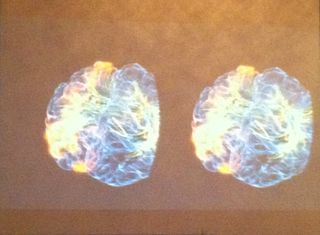Oculus Rift: 5 Virtual Reality Uses Beyond Gaming

Social media behemoth Facebook just paid $2 billion for Oculus VR, the virtual reality company that makes headsets and software hotly coveted by gamers. But Facebook creator and CEO Mark Zuckerberg is setting his sights far beyond immersive, first-person shooter video games.
"After games, we're going to make Oculus a platform for many other experiences," Zuckerberg said in announcing the deal Tuesday afternoon (March 25). "Imagine enjoying a court side seat at a game, studying in a classroom of students and teachers all over the world or consulting with a doctor face-to-face — just by putting on goggles in your home."
Zuckerberg isn't onto something new. For years scientists and engineers have been exploring the possibilities of using virtual reality technology outside the gaming world, from PTSD therapy for soldiers to controlling robot avatars. Some researchers have even used the compact Oculus Rift virtual reality goggles in their work. [Avatars to Brain Machines: 10 Coolest Military-Tech Projects]
Live Science brings you five possibilities:
1. Therapy for amputees and stroke victims
Virtual reality systems might eventually help people who have lost an arm or a leg and experience excruciating sensations known as phantom limb pain. One man missing an arm reported a dramatic reduction in pain after an experimental treatment in which muscle signals from the end of his arm controlled a virtual limb, according to a case study detailed last month in the journal Frontiers in Neuroscience. That study simply used a computer screen rather than more immersive virtual reality goggles, but other researchers in Vienna have been using the Oculus Rift headset to examine how such a system could help amputees learn to use a new prosthetic limb — a sometimes frustrating process.
Virtual reality could also help people who have lost function in one of their arms due to a stroke. A 2011 study found that people who had suffered a stroke were more likely to boost their arm strength if they played virtual games than if they underwent a standard course of physical therapy.
Sign up for the Live Science daily newsletter now
Get the world’s most fascinating discoveries delivered straight to your inbox.
2. Controlling robots on Mars
Researchers at NASA's Jet Propulsion Lab in Pasadena, Calif., recently unveiled a rig that allows an operator to use the Oculus Rift headset to see through the eyes of a robot avatar. The system also includes Kinect 2 motion-sensing software from Xbox One, which picks up the operator's gestures to move the robot's arm. It's not hard to imagine that one day such a system could allow humans on Earth to intimately control robots millions of miles away, in places like on Mars. Oculus Rift goggles have already been used to look at Mars virtually. Paired with the Virtuix Omni treadmill, the headset allowed JPL researchers to take a simulated stroll on the Red Planet using a 3D environment stitched together from images taken by the Mars rover Curiosity.

3. Seeing inside the body
Virtual simulations could give scientists and doctors an unprecedented view of the inner workings of human body. Computational neuroscientists demonstrated a "glass brain" at the South by Southwest (SXSW) Interactive festival in Austin, Texas, this month. By putting on a set of Oculus Rift goggles, users could see the brain activity in real-time of a person wearing a cap studded with electroencephalogram (EEG) electrodes attached to their head.
Computer scientists have even created a virtual reality simulator to model childbirth in 3D, taking into account patient-specific anatomy, the position of the baby and the basic forces exerted by the cervix, abdominal muscles and the doctor. Such simulations could help doctors navigate difficult pregnancies and prepare for a risky birth, according to the researchers who presented their work at a conference on E-Health and Bioengineering in Romania last year.
4. Treatment for PTSD

Military service members suffering chronic combat-related PTSD might benefit from therapy sessions that incorporate virtual simulations of the battlefield. Soldiers saw significant reductions in their PTSD symptoms after using a virtual reality headset that allowed them to confront and tolerate simulated memories and fears in environments like Iraq and Afghanistan, according to a study out this month in the journal Cyberpsychology, Behavior, and Social Networking.
5. Military training
Many soldiers today have experience with virtual reality simulators before they ever even get deployed. The U.S. Army actually uses game-like simulations such as "Virtual Battlespace 2" and noncommercial versions of "America's Army" to train and educate service members and prepare them for the mental horrors of war. The army's so-called Dismounted Soldier Training System uses a helmet-mounted headset with virtual reality goggles that can help replicate realistic environments when replica structures and mock villages just don't cut it.
Follow Megan Gannon on Twitter and Google+. Follow us @livescience, Facebook & Google+. Original article on Live Science.

Most Popular

